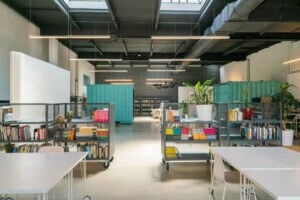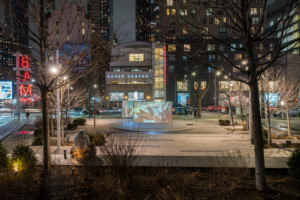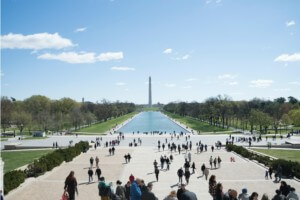It’s election day and The Architect’s Newspaper hopes you make (or already made) your trip to your polling place!
But as with almost every human activity, design plays a critical role at the ballot box (remember those hanging chads?). In preparation for 58th Presidential election, the Van Alen Institute hosted a competition (dubbed “Open Poll”) where interdisciplinary teams explored how to improve the voting experience. Open Poll asked how design could incentivize voting, make it more accessible for all, utilize the streetscape, and bring new energy to the democratic process.
The winning team took home $1,000 and the Van Alen Institute will work with them to further refine their proposal. We’ve included the winning proposal below, along with the two other finalists. For more on the competition, see the Van Alen website.
Winning Proposal: Voting at Your Fingertips: A National Celebration of the Democratic Process
Team: Racha Daher, Alexandra Gonzalez, and Elena Kapompasopoulou
The current voting process is inefficient, strenuous, wasteful, non-inclusive, and prone to human error. This proposal aims to change the way the voting process works, so that it is easier and inclusive, and is accurate, secure and transparent. It aims to change the mindset of the voting experience so that it becomes a national celebration of the democratic process, strengthening social and community ties. To do this, several strategies are to be implemented:
1. Digitalize the voting platform to facilitate the democratic voting experience (multi-step identity verification: SSN number, fingerprints, photo).
2. Increase number of public institutions that serve as polling stations (churches, post offices, libraries, city halls, schools).
3. Change the voting day to Sunday to allow all-day family events.
4. Transform parks and public spaces into event areas, re-engaging in activities, while broadcasting voting results to promote transparency.
5. Utilize street infrastructure for political engagement.
6. Hold national festivities to celebrate the democratic process.
Finalist Proposal: In Between the Lines
Team: Larissa Begault and Julia Borowicz
Most voting in NYC takes place in public schools, which provides an opportunity for civic engagement to occur within these educational institutions. Our proposal offers a curriculum of collective storytelling and cultural archiving. Given the current political rhetoric around national identity we need to reflect on diversity. This curriculum engages parents through excavating their histories while empowering children as the future generation of voters. Students collect their family history, highlighting diverse heritages across the U.S.
Once workshopped, the stories become an interactive artifact distributed to voters in line. Showcasing their plurality allows neighbors to find common ground through unexpected conversations around identity and difference. Addressing these themes bridges challenges around belonging and citizenship. This proposal offers an occasion to reflect on what unites us.
Finalist Proposal: Re-Thinking Urban Elections
Team: Vahhab Aboonour and George Dimos
Our proposal examines the importance of public spaces, like parks, plazas or college campuses, as democratic archetypes promoting social interaction and political education. We are re-thinking the poll site, incorporating elements from the ancient Greek agora and the Parisian café scene, as a place where political conversation can spontaneously occur. We propose that Election Day becomes a national holiday that both public and private organizations respect. Voters are therefore given more time to travel to their poll sites and share views with their communities. Furthermore, the private sector can actively participate in the electoral process, with college campuses serving as poll sites, and students working at the polls, getting paid through their workstudy awards. Voting then becomes an educational and celebratory public event.










